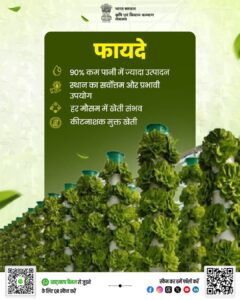अब खेती होगी प्राकृतिक, किसान होंगे आत्मनिर्भर! आइए जानें, राष्ट्रीय प्राकृतिक खेती मिशन (#NMNF) से किसानों को मिलने वाले लाभ।
The National Natural Farming Mission (NNFM) is a transformative initiative by the Government of India to promote chemical-free, sustainable agriculture, ensuring farmers become self-reliant while protecting the environment. By shifting from conventional farming to natural farming practices, farmers can reduce costs, improve soil health, and achieve higher profitability.
At Kruhsi Tools, we support this mission by providing farmers with innovative, eco-friendly farming tools that align with natural farming principles. Let’s explore the key benefits of the National Natural Farming Mission for farmers. National Natural Farming Mission: Empowering Farmers for a Self-Reliant Future.
Key Benefits of the National Natural Farming Mission for Farmers
1. Reduced Dependency on Chemical Inputs
- Natural farming eliminates the need for synthetic fertilizers and pesticides, reducing input costs.
- Farmers use cow dung, cow urine, jaggery, and local biomass to prepare natural inputs like Jeevamrit and Beejamrit.
2. Improved Soil Health & Fertility
- Promotes microbial activity and enhances organic carbon in the soil.
- Prevents soil degradation, ensuring long-term productivity.
3. Lower Production Costs, Higher Profits
- By avoiding expensive chemicals, farmers save up to 50% on input costs.
- Higher demand for organic produce leads to better market prices.
4. Climate-Resilient Farming
- Natural farming conserves water and increases drought resistance.
- Reduces greenhouse gas emissions, contributing to sustainable agriculture.
5. Healthier Food & Better Livelihoods
- Produces chemical-free, nutritious food for consumers.
- Improves farmers’ income and reduces health risks from chemical exposure.
6. Government Support & Incentives
- Financial assistance for training, infrastructure, and organic certification.
- Subsidies for natural farming inputs and Krishi Vigyan Kendras (KVKs) provide training.

How Kruhsi Tools Supports Natural Farming
At Kruhsi Tools, we design durable, eco-friendly farming equipment to help farmers transition smoothly to natural farming. Our tools include:
- Organic Waste Composters – For making natural fertilizers.
- Zero-Till Seed Drills – To maintain soil structure.
- Manual Weeders & Mulchers – Reducing chemical herbicide use.
Conclusion
The National Natural Farming Mission is a game-changer for Indian agriculture, empowering farmers to adopt sustainable, low-cost, and high-profit farming. By embracing natural farming, farmers can ensure food security, environmental protection, and economic independence.
Kruhsi Tools is committed to supporting this mission with innovative farming solutions. Join the natural farming revolution today for a greener, healthier, and self-reliant future! National Natural Farming Mission: Empowering Farmers for a Self-Reliant Future.
Call to Action
Explore Kruhsi Tools’ range of natural farming equipment and take the first step towards chemical-free, profitable farming!













